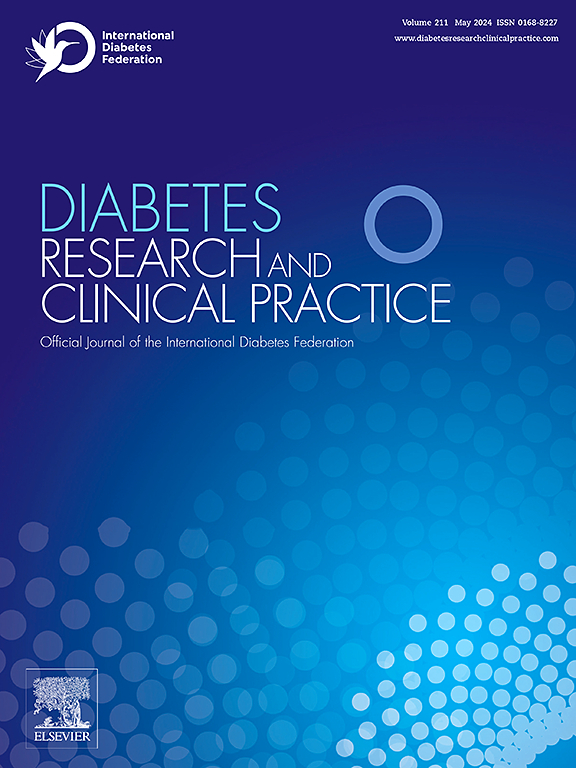2025年全球1型糖尿病患病率、发病率和死亡率估计:来自国际糖尿病联合会地图集第11版和T1D指数3.0版的结果
IF 6.1
3区 医学
Q1 ENDOCRINOLOGY & METABOLISM
引用次数: 0
摘要
在全球范围内,症状型1型糖尿病(T1D)的患病率差异很大。国际糖尿病联合会第11版图集/T1D指数3.0版估计了202个国家/地区(“国家”)2025年的数字,并预计到2040年。方法T1D指数模型是一个马尔可夫模型,具有随时间发病率、成人发病率和随时间死亡率的子模型,并根据最近基于人群的T1D发病率、死亡率和患病率研究进行更新。对于没有研究的国家,数据是从具有类似背景的国家推断出来的。结果全球估计有950万T1D患者(2021年为840万,增长13%),其中100万年龄在0-14岁,80万年龄在15-19岁。在低收入国家,流行病例增加了20%,从2021年的180万例增加到2025年的210万例。2025年的发病率估计为51.3万例(0-14岁16.4万例,15-19岁5.8万例),去年的发病率增加了2.4%。据估计,过早死亡人数为17.4万人,其中17.2%是由于在临床发病后不久未得到诊断。据估计,到2025年,被诊断患有T1D的10岁儿童的剩余预期寿命因国家而异,从6岁到66岁不等。目前仍没有119个国家的数据。预计到2040年,T1D人口将达到1470万。结论由于诊断发病率上升、死亡率下降、老龄化和人口增长,全球T1D病例数量正在迅速上升,特别是在低收入国家。超过50%的国家没有当代数据,这突出表明需要进行流行病学研究。本文章由计算机程序翻译,如有差异,请以英文原文为准。
Global type 1 diabetes prevalence, incidence, and mortality estimates 2025: Results from the International diabetes Federation Atlas, 11th Edition, and the T1D Index Version 3.0
Aims
Globally, symptomatic type 1 diabetes (T1D) prevalence varies markedly. The International Diabetes Federation 11th Edition Atlas/T1D Index Version 3.0 estimated 2025 numbers for 202 countries/territories (“countries”), and projected to 2040.
Methods
The T1D Index model, a Markov model with sub-models for incidence-over-time, adult incidence, and mortality-over-time, was updated with recent population-based T1D incidence, mortality and prevalence studies. For countries without studies, data were extrapolated from countries with similar settings.
Results
There are estimated 9.5 million people living with T1D globally (compared to 8.4 million in 2021, a 13 % increase), with 1.0 million of these aged 0–14, and 0.8 million aged 15–19 years. In lower-income countries, prevalent cases increased by 20 % from 1.8 million in 2021 to 2.1 million in 2025. Incident cases in 2025 are an estimated 513,000 (164,000 aged 0–14 and 58,000 aged 15–19 years), with incidence increasing by 2.4 % in the last year. Premature deaths are estimated at 174,000, with 17.2 % of these due to non-diagnosis soon after clinical onset. The estimated remaining life expectancy of a 10-year-old child diagnosed with T1D in 2025 varies between countries from 6 to 66 years. There are still no data available for 119 countries. The projected T1D population for 2040 is estimated to be14.7 million.
Conclusions
The number of global T1D cases is rising quickly, especially in lower-income settings, due to increasing diagnosed incidence, falling mortality and ageing, and population growth. Contemporary data are unavailable for over 50% of all countries, highlighting need for epidemiological studies.
求助全文
通过发布文献求助,成功后即可免费获取论文全文。
去求助
来源期刊

Diabetes research and clinical practice
医学-内分泌学与代谢
CiteScore
10.30
自引率
3.90%
发文量
862
审稿时长
32 days
期刊介绍:
Diabetes Research and Clinical Practice is an international journal for health-care providers and clinically oriented researchers that publishes high-quality original research articles and expert reviews in diabetes and related areas. The role of the journal is to provide a venue for dissemination of knowledge and discussion of topics related to diabetes clinical research and patient care. Topics of focus include translational science, genetics, immunology, nutrition, psychosocial research, epidemiology, prevention, socio-economic research, complications, new treatments, technologies and therapy.
 求助内容:
求助内容: 应助结果提醒方式:
应助结果提醒方式:


